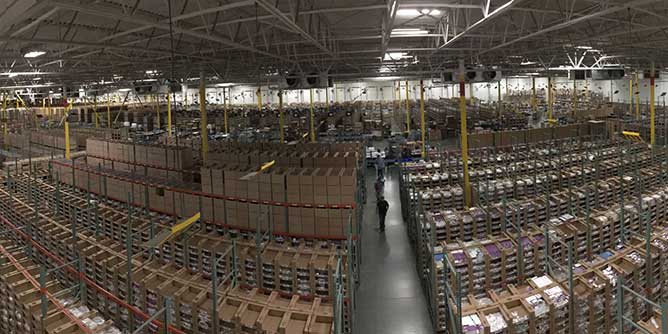Webinar Registration: The P2G Advantage
Webinar Registration: The P2G Advantage LEARN MORE
What are Autonomous Robots? 8 Applications for Today’s AMRs
Jason Walker, Vice President, Market Development

What is autonomy? For humans, autonomy is what allows us to do tasks, like walking, talking, waving, opening doors, pushing buttons, and changing light bulbs. In robots, autonomy is no different.
Autonomous robots, just like humans, can also make their own decisions and then perform an action accordingly. A truly autonomous robot is one that can perceive its environment, make decisions based on what it perceives and/or has been programmed to recognize, and then actuate a movement or manipulation within that environment. With respect to robot mobility, for example, these decision-based actions include, but are not limited to, basic tasks like starting, stopping, and maneuvering around obstacles that are in their way.
Before discussing what truly makes a robot autonomous, let’s discuss one of the most common misconceptions surrounding mobile robots today.
What are Autonomous Robots?
True autonomous robots are intelligent machines that can perform tasks and operate in an environment independently, without human control or intervention. This level of autonomy gives the workforce the ability to delegate dull, dangerous, or dirty tasks to the robot so humans can spend more time doing the interesting, engaging, and valuable parts of their job.
For the last 15-20 years, the popular use of robotics has largely involved tele-operated mobile robots equipped with cameras being used to get eyes on something out of reach, or extremely simple industrial or warehouse applications. For example, not only are Automated Guided Vehicles (AGVs) being used to move materials in factories and warehouses, but flying robots (aka drones) are being used for disaster response, and underwater robots are being used to search and discover shipwrecks in the deepest depths of our oceans. While this use of robots has proven incredibly effective over the years, these examples in no way represent the use of truly autonomous robots.
The term “robot” has been utilized repeatedly through the years by companies that want their customers to think their product is some sort of sophisticated Artificial Intelligence (AI). Additionally, the true definition of an autonomous robot has also been oversimplified and often used interchangeably with what amounts to pre-programmed machines—not to mention automated actuators like robotic arms or motion control systems.
The Worst Example of a (Not Really) Autonomous Robot
Quite frequently, the classic industrial machines you see in an assembly line for a car manufacturer are mislabeled as robots. While they are amazing feats of engineering, they are not robots at all and are instead like milling machines that operate off computer numerical controls (CNC).
Unlike a truly autonomous robot, these industrial machines are pre-programmed to perform a repetitive movement. They are not able to react. For example, what would happen if one of these so-called robots responsible for installing spare tires in the trunk of a car encountered a random situation in which the trunk was shut. Would the “robot” know not to install the tire? Probably not. Instead, this machine would continue to perform its programmed task and would most likely end up smashing the tire right through the trunk lid. If this machine was truly an autonomous robot, then it would know not to install the tire based on the information it gathered from perceiving the situation and knowing that the trunk was not in fact open.
Why the Roomba is a Real Autonomous Robot
To fully understand autonomous mobile robots, it helps to see them in action. And one of the most well-known, and arguably most prolific, truly autonomous robot on the market today is the Roomba. While the Roomba is a consumer product, its capabilities and functionality translate to the warehouse and industrial space and have made AMRs a much more widely accessible technology.
The Roomba can make decisions and act based on what it perceives in its environment. It can be placed in a room, left alone, and it will do its job without any help or supervision from a person.
A set of sensors allows the Roomba to perceive its environment, decide a course of action based on these perceptions, and then take that appropriate action. The same concepts apply to warehouse robots — if an AMR encounters an obstacle (like a pallet) while it is performing set tasks on the warehouse floor, it will navigate around the issue and continue without human interference.
Simply put, an autonomous robot is one that decides the action it should take on its own based on information it has perceived. If you would like to learn more about autonomous robots or their endless possible applications, contact us today. If you are not sure how an autonomous mobile robot might be helpful to you, here are 8 great examples.
8 Applications of Autonomous Robots
- AMRs for Logistics
While the capabilities of AMRs continue to advance, the most basic and widely used application for these machines is for material transport. AMRs can transport orders across a warehouse or through a shipping facility countless times a day. Transport is a labor-intensive job and utilizing robots for these tasks is one of the easiest ways to free up human workers for more important jobs without disrupting workflows.
- AMRs for E-Commerce
AMRs for e-commerce applications can come in many forms, from moving carts to mobile manipulation and more. Because AMR platforms can include multiple accessories, their flexibility makes them ideal for a number of applications, even within specific applications like transport and sortation.
Today we see AMRs utilized in tasks like:
- Order fulfillment
- Returns handling
- Raw materials transport and sorting
- Parcel sortation
- Inventory management
- AMRs for Warehousing
Warehouses and distribution centers today are massive, with some spanning more than 1 million square feet. When AMRs are utilized in warehousing applications for automation, they are best suited to do the heavy lifting and transport of goods throughout the space. Tasking AMRs with basic warehousing ops reduces the time workers spend traveling in a warehouse, allowing them to work on more value-added tasks.
One feature of note for AMRs is their ability to “see” and localize in open spaces. AMRs use lasers to scan their environment and their embedded systems analyze the sensor data, enabling them to see obstacles and navigate safely. However, enormous warehouses lack the walls, posts, and other fixed features that many AMRs need to effectively navigate. This environment requires an AMR that has a navigation system specifically designed for warehouse operation.
Another important task in warehousing and distribution is palletizing, a monotonous, repetitive process that is well suited for automation. To speed up this task and empower workers to do other jobs, AMRs are now being applied to palletizing. With AMR platforms, lift plates, and robotic arms, palletizing can be almost completely automated. Palletizing robots can complete every step of the process – loading, transport, and unloading – autonomously, efficiently, and accurately.
- AMRs and Mobile Manipulators for Manufacturing
The versatility of AMRs makes them ideal for the ever-changing, dynamic world of manufacturing. AMRs that are designed to be easily set up and used by workers within existing factories allow companies of any size to leverage AMRs’ capabilities for an endless variety of tasks.
Beyond transporting in-process parts and finished goods, AMRs integrated with accessories such as conveyors or robotic arms, can assist in the production process. For example, AMRs with robotic arms can sort, pick, and pack products with the added ability to dynamically move to multiple locations.
Static conveyors have long been used in line work, as they help speed up production and sorting. Adding a conveyor onto an AMR means that conveyor capabilities can now be flexible and mobile. AMRs with built-in conveyors can connect to static conveyors to move products more effectively throughout a facility.
AMRs with attachments that can lift loads and connect to carts allow the robots to load and unload payloads and, in some cases, connect to carts without human intervention. This combination of the cart transport and loading/unloading in one AMR is a relatively new capability, but one that will create more potential applications for autonomous robots.
- AMRs for Data Centers
Secure autonomous transport is an integral part of operations at data centers and research facilities, which has created a new application for AMRs. Autonomous robots outfitted with lock boxes and cabinets can be used to safely transport high value materials and ensure that the proper chain of custody protocol is followed. This also enables instant, accurate, and easily accessible documentation of the process.
- AMRs in Healthcare
As the capabilities and ease-of-use improves for AMRs, many industries are finding innovative applications for robots. Today we are seeing more autonomous robots being utilized in the healthcare field for a variety of tasks.
First and foremost, AMRs are a useful tool to streamline transport of supplies and medicine throughout a healthcare facility. This is even more important in infectious disease units as it prevents nurses from coming into frequent contact with potential contaminants, but still ensures that patients receive proper treatment. Secondly, medical AMRs can also be used in sanitation—robots can be outfitted with virus-killing UV lights or decontamination sprays that clean up a room or space without exposing people to potential harm.
- AMRs in Biotech
While facing a fast-growing market for biopharmaceuticals, biotech companies need to comply with strongly regulated production processes, which can mean labor-intensive tasks. For example, sampling and maintenance of cell culture processes are labor-intensive and require constant monitoring on a 24/7 basis. Autonomous mobile robots combined with robotic arms can be used to control valuable process inputs, perform regular monitoring tasks, and safely manage waste removal from the production line.
With AMRs handling the repetitive tasks, workers can focus on critical steps in the biopharmaceutical manufacturing process such as tracking of growth parameters, continuous testing, and making necessary adjustments as development progresses.
- AMRs for Research and Development
For research and development, AMRs are used to minimize tedious transport tasks involved in repetitive testing or other engineering requirements. In addition, AMRs are increasingly becoming a part of the research itself.
For example, one hot area of innovation is the development of sensors and robotic manipulation technology. As these studies advance, researchers are looking for ways to mobilize the technology, but many organizations don’t have the time or funding to build their own platforms. With a flexible AMR, the sensors and manipulators used for research can be easily integrated into the mobile platform, providing easy to use, autonomous mobility to these developing technologies and saving companies and research institutions considerable time and money in the development process.
Crucial Components of an Autonomous Robot
The key components to the autonomous action mentioned above include these three key concepts: perception, decision, and actuation.
Perception
For people, perception is almost entirely performed by our five senses. Eyes, ears, skin, hair, and many other biological mechanisms are used to perceive the world. For a robot, perception means sensors. Laser scanners, stereo vision cameras (eyes), bump sensors (skin and hair), force-torque sensors (muscle strain), and even spectrometers (smell) are used as input devices for a robot to help it “see” and perceive its environment. And with both people and robots alike, we can now think of other kinds of information inputs, like the endless supply of data from the internet; in fact, one might think of the Internet of Things as an endless sea of sensors with very long wires reaching back to the robots that might use them.
Decision
For humans, it’s our brain that makes most of our decisions; or in some cases our “gut” or even our neural system. Our brains make higher level decisions, like where we want to walk, for example. But sometimes our biology supersedes our brains, and our bodies react to things before our brains even know what’s happening. Those reflexive behaviors, like eyelids closing to block a flying piece of debris, are operating faster and without the permission of our brains for the purpose of keeping us safe.
Autonomous robots have a similar decision-making structure. The “brain” of a robot is usually a computer, and it makes decisions based on what its mission is and what information it receives along the way. But robots also have a capability that is like the neurological system in humans, where their safety systems operate faster and without the permission of the brain; in fact, in robots, the brain operates with the permission of the safety system. In an autonomous robot, we call that “neurological” system an embedded system; it operates faster and with higher authority than the computer that is executing a mission plan and parsing data. This is how the robot can decide to stop if it notices an obstacle in its way, if it detects a problem with itself, or if its emergency-stop button is pressed.
Actuation
People have actuators called muscles. They come in all kinds of shapes and perform all kinds of functions, from grabbing a cup of coffee to beating our hearts and pumping blood. Robots can have all kinds of actuators, too, and a motor of some kind is usually at the heart of the actuator. Whether it’s a wheel, linear actuator, or hydraulic ram, there’s always a motor converting energy into movement.
Our full fleet of autonomous mobile robots have perception (through their LiDAR and vision technology); decision-making; and actuation in the form of wheels. They are able to work in any part of your warehouse and move material around the warehouse, eliminating unproductive walking time for humans to significantly improve productivity and lower cycle times.
Interested? Let’s talk!
About the Author
Jason has over 20 years of robotics leadership roles that range from managing QA and testing for iRobot’s Roomba to co-founding CyPhy Works, a revolutionary tethered drone company. Most recently, Jason was Co-founder and CEO of Waypoint Robotics, a leading provider of heavy payload capacity, omnidirectional AMRs, that was acquired by Locus in 2021. Jason is a life-long roboticist and has won many awards, accolades, and patents for various robot-related technologies. Jason is using his vast knowledge and experience to propel Locus into new opportunities.




